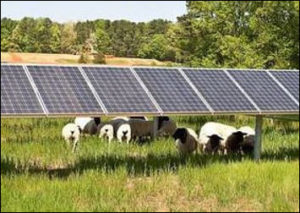My 3rd great grandfather came to Augusta County in the 1820s, cleared land and established crops on land that is still in our family. Several of my neighbors could tell similar stories. We love farming, but it’s a hard life. Incredible increases in productivity have kept agricultural commodity prices depressed for 80 years. To keep up with the latest and greatest agricultural machinery and technology, farmers have borrowed heavily, using their ancestral lands as collateral. One or two bad years, and they go broke. Many see no way out of their cycle of indebtedness.
Today there is light at the end of the tunnel, so to speak, and that light comes from the sun. Large-scale solar farms offer landowners a low-risk means to keep their farm land. They can lease acreage to a solar developer for a guaranteed income over 25 years. At the end of the lease, they can easily convert the land back to agricultural production with no degradation of soil quality or health.
Solar development has become an issue in Virginia counties. Many local governments have acted to discourage it. Local planners and supervisors want to be involved with any lease decisions the farmer is involved with, and they want to make approvals contingent upon land use restrictions and kickbacks to the localities. Local jurisdictions have created a maze of hurdles and gates that must be navigated before they would even consider permitting a solar facility. A facility that no one works in, lives in or visits gets more scrutiny than an apartment building, office building or Walmart.
It is helpful to consider why Virginia has Agricultural-zoned property. The zoning is meant to reflect what the land was used for more than a hundred years ago, prior to any zoning ordinances. Subdivisions and strip malls were gobbling up farm land, and zoning ordinances were invoked to protect farmers from rising prices and property taxes. Ironically, it is easier to get approval to rezone agricultural zoned property for residential or commercial use than to get for a low impact solar project.
A case in point was the proposed Strata Solar Project in Augusta County on land owned by Dennis Bradley and Alan Bocock. The project received so much local political resistance that the developer pulled out. What will happen to the Bocock and Bradley properties now? Once solar development is ruled out, the most economical choice is residential and commercial development. Once houses, strip malls and parking lots are built, the land will never be returned to productive agriculture.
Agricultural products sustained the families of the early farmers and eventually the nation. Today we have another critical need that only large agricultural properties can satisfy. As our society and economy change, we need electricity generated from renewable sources. It is only reasonable to utilize agricultural property for solar projects that will generate efficient and clean electricity.
Some fear that devoting farmland to solar farms will harm the agricultural industry. Not so. Without the solar option, many farms, like the Bradley and Bocock properties, would be sold eventually for housing and commercial development. Localities should embrace large-scale solar development with the recognition that this alternative to conventional farming will help preserve and protect our county, state and country from urban sprawl and congestion.
James Lee Kindig owns Kinmont Farm in Waynesboro. As the 6th generation of the family to farm this property, he has traveled the United States in search of breeding stock. His search led to finding the first Charlois homozygous polled bull, which revolutionized the Charlois breed from a purely horned to purely polled breed. Kinmont Farm Charlois set records at Virginia BCIA feed tests and National Charlois sales. Expanding from a relatively small acreage property, Kinmont Farm, at one time leased more than 5,000 acres of pasture and hay land in four counties to accommodate the expanding herd of 1,000 head of registered Charlais.


Leave a Reply
You must be logged in to post a comment.